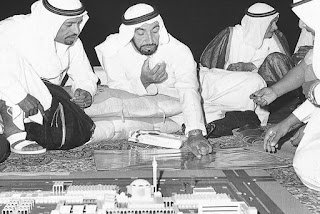The Evolution of Abu Dhabi's Urban Design: A Walk with Lukas Sokol
Lukas Sokol, Urban Design Manager at the Abu Dhabi
Department of Urban Planning and Municipalities, took some of us on a
remarkable walk through central Abu Dhabi as part of Inter-Emirates Weekend
2018 to point out the areas where the city’s historical roots can still be
seen. He built on the topic this past May, with his lecture, “The Abu Dhabi
Superblock: Adaptation, Evolution, and Livability in the Modernist
Grid,” an overarching look at how, and more importantly, why Abu Dhabi developed the way it did.
In a word: Modernism. In a name: Sheikh Zayed.
Photo from https://yallaabudhabi.ae/featured_events/humanity-in-the-poetry-of-the-late-sheikh-zayed/
It cannot be overstated how
profoundly Sheikh Zayed influenced the development of Abu Dhabi and the wider
UAE. He left no stone unturned in constructing the best future for his people, and in fact his famed attention to detail can be seen in
the fabric of the city itself.
Pre-oil, Abu Dhabi was largely a
community of barasti huts around several mosques and the Qasr al Hosn, the
historic fort, which itself was built around a natural spring. Those arriving
from the sea would navigate past a coral reef and disembark on a sand spit that
was formed by the curving of the waves around the reef. They would walk through
the village to the Fort on a well-worn trail.
The traces of this path can still
be seen on of Airport Road, which widens at the bottom, the point of the old
port. Lukas’ planning department envisions developing this route as a ‘Heritage
Trail,’ highlighting the old buildings that still line its route, such as the
old Juma (Friday) mosque, called the Al Otaiba mosque after one of the
Emirate’s oldest families. Today there is a newer, larger mosque on the same
site called the Sheikh Khalifa mosque.
When oil was discovered in the early
1960’s [fun fact: a key player in the discovery of off-shore oil in Abu Dhabi
was famed explorer Jacques Costeau!], Sheikh Zayed was one of the few people that grasped how radically an influx of capital and foreign influence
would change the country, and started the Herculean task of harnessing this
wave of affluence to benefit his people.
One method was urban design. Citizens
were given residential, commercial and agricultural lots. With the nascent
urban planning council under renowned architect John Eliot, the downtown core
was laid out in a grid, and the major intersections marked. Sheikh Zayed
himself oversaw this, driving around with a team of soldiers who would stake
out each intersection.
Eliot and Sheikh Zayed’s vision
was a garden city designed with the principles of accessibility and openness. Thus
the modernist idea of the ‘superblock’ was overlaid on top of the sand—quite
literally, since Sheikh Zayed would often sketch out his many ideas in the
sand, leaving Eliot to commit them to paper.
The idea was to preserve a
neighbourhood feel by pushing commercial outlets and offices to a ring of large
towers surrounding an interior ‘village’ of villas and smaller businesses that
were interlaced with ‘sikka,’ small footpaths that were a traditional feature
of the old barasti villages.
Lukas led us through one of these
older city blocks, where the villas and mosques still exist, surrounded by the perimeter of larger commercial buildings. It does have an urban
village feel, right down to the resident poultry.
Sheikh Zayed’s influence can also
be felt in the design of the buildings themselves. He insisted that they
display Middle-Eastern design influences, which is why the older buildings boast
features like arched windows and geometric patterns--but no lack of style!
Sheikh Zayed went on to forge a
long-term partnership with Egyptian planner Dr. Abdulrahman Makhlouf, with whom
he deepened the use of the grid that still shapes Abu Dhabi today.
During our walk, Lukas also discussed how the Corniche was
extended in 2002-03, so in the photo below, we would have been standing
waist-deep in water.
This photo was taken across from the old Hilton Baynunah building, which itself was previously right on the Corniche.
Although the city continues to
grow and change, and despite the fact that Eliot and Sheikh Zayed had
originally planned for 350,000 inhabitants, their imprint has remained, along
with it the philosophy that the city is a space to be used effectively by all,
and above all, to be enjoyed.









Comments
Post a Comment